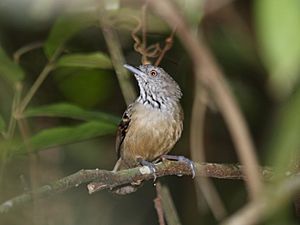Checker-throated stipplethroat facts for kids
Quick facts for kids Checker-throated stipplethroat |
|
|---|---|
 |
|
| Conservation status | |
| Scientific classification | |
| Genus: |
Epinecrophylla
|
| Species: |
fulviventris
|
 |
|
| Synonyms | |
|
|
The checker-throated stipplethroat (Epinecrophylla fulviventris) is a small bird in the antbird family. It is also known as the fulvous-bellied antwren or checker-throated antwren. This bird was once thought to belong to a different group, but scientists have now placed it in a new genus called Epinecrophylla. They made this change after studying the bird's genes, how it acts, its calls, and its body shape.
Contents
Where it Lives
This bird lives in warm, tropical areas. You can find it from southeastern Honduras in Central America all the way to western Ecuador in South America. In Central America, it prefers the lowlands and foothills near the Caribbean Sea. It usually lives at altitudes up to 700 meters (about 2,300 feet).
What it Looks Like
The checker-throated stipplethroat is about 10 centimeters (4 inches) long. It weighs around 10.5 grams, which is about the same as a few paper clips.
Both male and female birds have olive-brown feathers on their backs and wings. Their undersides are a lighter buff-brown color. Their wings are dark, with buff-colored stripes.
- The adult male has a dark throat with many white spots. His chest has a grayish tint, and the sides of his head are dusky.
- The adult female has a buff-colored throat and a buff-colored central chest.
- Young birds are brighter and more cinnamon-colored than the adults. Their wing stripes are not as clear, and they have pale streaks on their undersides.
This bird makes a thin cheep sound. Its song is a loud tseek-tseek-tseek-tseek.
What it Eats and How it Behaves
Checker-throated stipplethroats are usually seen in pairs or small groups. They often join larger groups of different bird species that are feeding together.
They eat insects and spiders. They look for eggs, young (larvae), and adult insects and spiders. They find their food in leaf litter on the ground. They also search in plants that grow on other plants (called epiphytes) and in tangled vines. They usually search for food in low plants or on the ground.
This bird is common in the lower parts of wet forests. It also lives in nearby areas where tall second-growth plants are growing.
Nesting and Young Birds
The female checker-throated stipplethroat lays two eggs. The eggs are white with lilac or red-brown spots. Both the male and female birds take turns sitting on the eggs to keep them warm.
Their nest is shaped like a deep pouch, about 15 centimeters (6 inches) deep. It is made from plant fibers and dead leaves. The nest hangs from the very last fork of a thin twig, usually less than 2 meters (6.5 feet) off the ground. Both parent birds work together to feed their young chicks.
When male birds meet at the edges of their territories, they have a special display. They perch about 30 centimeters (1 foot) apart. They lower their heads, puff out their feathers, and sway from side to side in opposite directions.
See also
 In Spanish: Hormiguerito Leonado para niños
In Spanish: Hormiguerito Leonado para niños


